Killer whales, also known as orcas, are a huge part of our world and one that we should all be aware of. These marine animals are found in all of the world’s oceans, and although they are not endangered, they are protected under the Marine Mammal Protection Act in the United States.
- Status: Deficient Data
- Known as: Killer Whale, Orca, Orca Whale, Blackfish, Orcinus orca
- Estimated numbers left in the wild: At least 50,000, probably quite a bit higher.
They are so named because of their reputations as fierce predators, and although they are not known to specifically target humans, they have been known to attack and kill people in the wild.
These whales are also very intelligent animals and have been known to communicate with each other using a variety of sounds and clicks.
Description
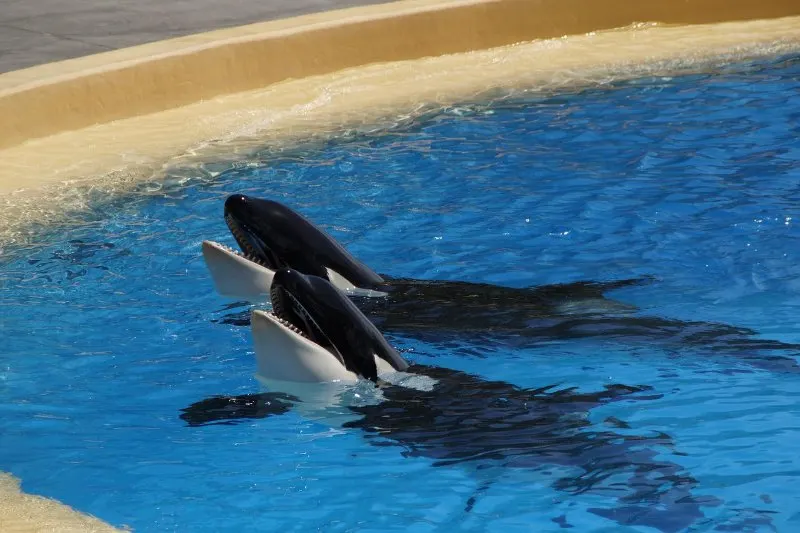
Killer whales are strong and aggressive apex predators, hunting the seas in large groups or “pods,” and mostly immune from predation.
They are brilliant and can devise unique methods of catching prey in special circumstances, which other orcas can then learn through observation.
They have a large, extended social life. Beyond the pod, there are “clans” made up of several loosely allied pods and communities composed of several clans.
Mating usually occurs outside the pod but within the clan or community. Orcas are usually born in winter, and if they survive their first few months (which only half of the young killer whales do), they may live as much as 90 years, though most do not survive beyond their forties or fifties.
Anatomy and Appearance
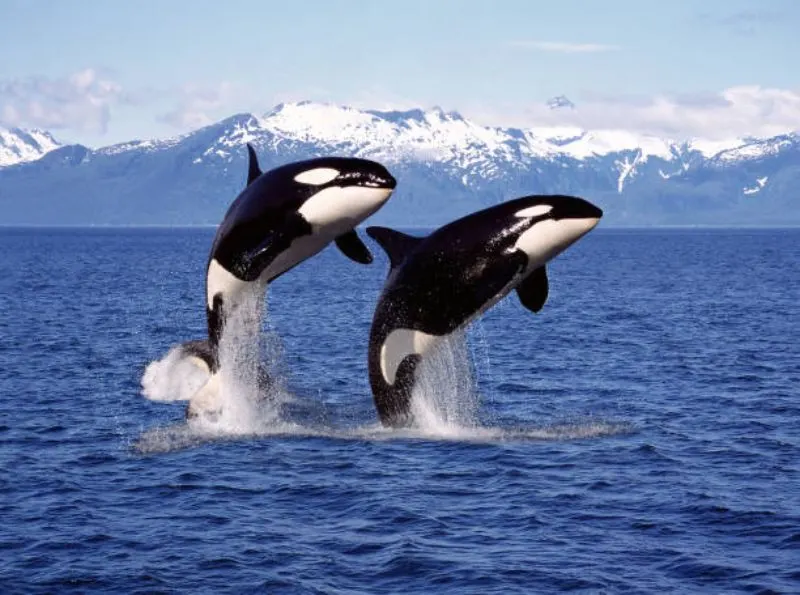
Orcas are also known as social animals and may form pods of up to 40.
They are intelligent creatures with large brains and cooperate in hunting, somewhat like wolves or other canine species on land. Different pods seem to adopt different “tactics” or “cultures” depending on their prey.
Those resident pods specializing in hunting fish tend to live in one place for long periods, while those that prey on seals or other larger prey move from one place to another in search of their quarry and have no fixed abode.
Killer whales, which are actually highly predatory dolphins, weigh up to 5,400 kilograms and can measure up to 9.7 meters long.
Males orcas are about 25% larger than female Killer whales and have a protrusion on the top of their head that is used for fighting.
They also have more black coloring on their body than females. Females are typically lighter in color and have a more curved dorsal fin. They have a distinctively shaped head with a large bulbous forehead, called the melon.
These sea-dwelling mammals are very distinctive looking and magnificent creatures, with their powerful but streamlined bodies, crisp black and white coloration, and prominent dorsal fin.
These whales sometimes travel up to a hundred or so kilometers up a freshwater river searching for fish. They are highly efficient carnivores whose 10-centimeter teeth make short sea birds, seals, fish, squid, and other marine animals.
An adult killer whale needs around 225 kilograms of food daily to remain healthy.
Killer whales occasionally take large whales also. They cannot kill blue whales or adult male sperm whales but can kill calves by exhausting and drowning them and sometimes adult females.
Being up on a beach does not protect seals from orcas since killer whales will haul themselves out a short distance on land to seize prey.
See Related: Whale Shark
Location
Killer whales are found in every ocean and sea of the world, except a few inland seas such as the Dead Sea and the Aral Sea.
They are most common at high latitudes, where there is abundant prey, and prefer coastal waters, sometimes even entering rivers and traveling far upstream. They are also sometimes found in the deep ocean.
See Related: Environmental Organizations in South America
Killer Whale Habitat
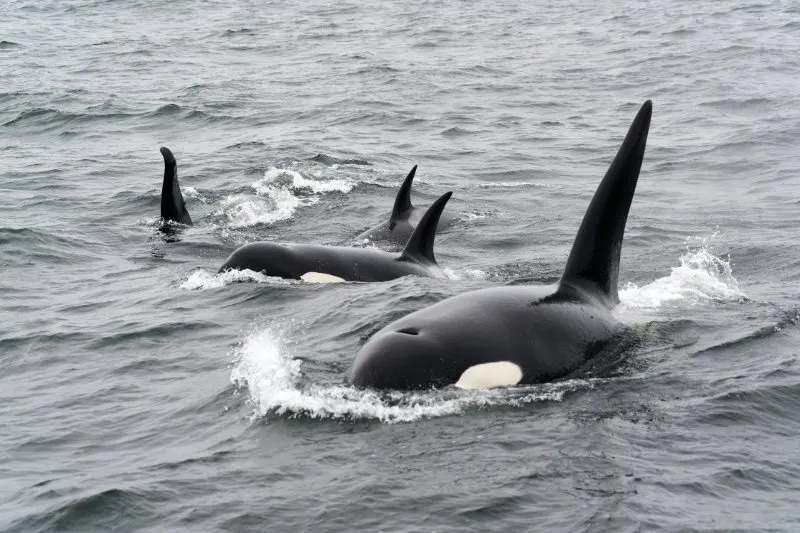
These whales or the Orcinus orca can be found in all of the world’s oceans. They are usually seen in colder waters near the poles, but they have been spotted in all of the world’s seas.
Killer whales are very adaptable and can live in a wide variety of habitats, including open ocean, coastal waters, and even estuaries.
Killer Whale Diet and Nutrition
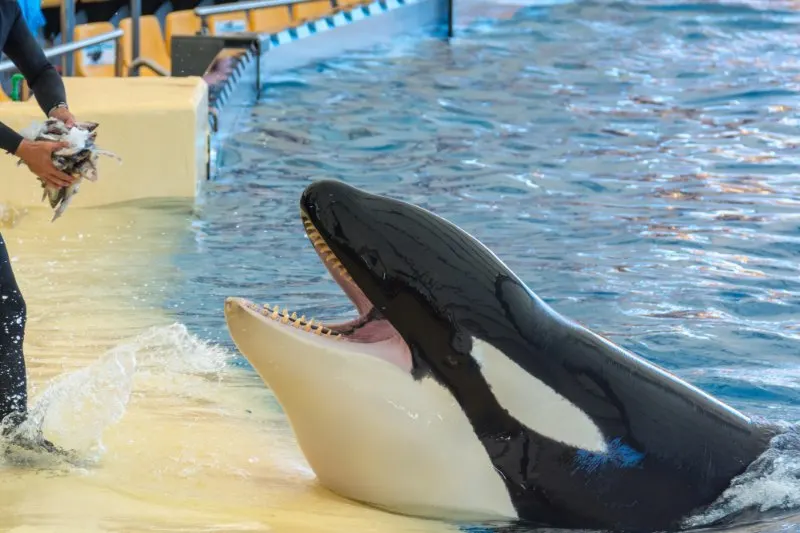
Killer whales are apex predators, meaning they are at the top of the food chain in their environment. Killer whales eat fish, but they have also been known to eat seals, sea lions, porpoises, and other whales.
These whales are opportunistic feeders, which means they will eat whatever is available to them. Killer whales eat between six and eight percent of their body weight each day, so they would typically eat around 50-100 pounds of food per day.
Hunting
Killer whales are predatory animals that feed primarily on fish, but they will also consume other marine mammals, such as seals, sea lions, and porpoises.
They use their echolocation to hunt down prey, which they then stun with their powerful jaws before eating. These marine mammals have even been known to kill great white sharks.
Killer Whale Mating Habits
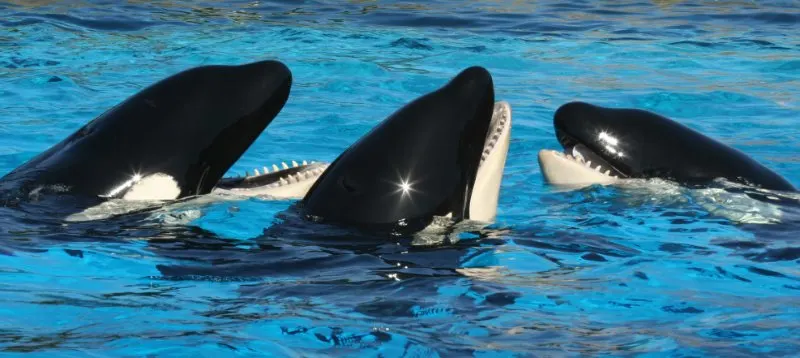
Killer whales are one of the most fascinating creatures in the sea.
They are also one of the most mysterious. These marine mammals’ mating habits are still not fully understood, but there is still a lot that we do know. Killer whales are known to be quite playful and social animals, and their mating rituals are no exception.
One thing that is interesting about Killer Whale mating is that it can be quite violent. They s are known to engage in ritualized fighting with each other during mating season.
The fights are usually over the right to mate with a particular female, and they can be quite brutal. These fights can often result in serious injuries and even death.
Despite the violence, mating is a very important process for the survival of the species. These animals have a very low reproductive rate, so it is crucial that they mate successfully.
Killer whale calves are also highly dependent on their mothers for the first year or two of their lives, so it is important that the mother has enough energy to care for her calf.
These marine mammals populations are not currently endangered, but they are still at risk.
They are threatened by things like pollution and climate change, so it is important that we do our best to protect them. Killer whales are an important part of our oceans and we should do everything we can to keep them healthy and thriving.
See Related: Dwarf Sperm Whales: Are they Endangered?
Life Cycle
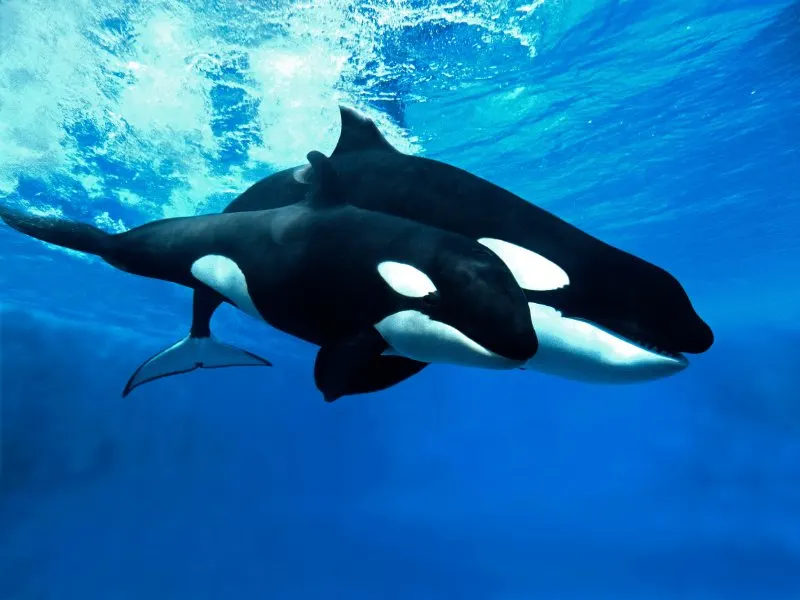
Killer whales start their lives as embryos that develop inside their mothers. The whales will remain in the womb for around eighteen months, after which they will be born.
Killer whale calves are normally around six to eight feet long and weigh around two hundred and fifty pounds.
They will nurse from their mothers for up to a year and a half and will stay with their mothers until they are around six years old. Whales are very social animals and live in pods of up to forty individuals.
Killer whales can live in the wild for up to 50 years. These whales in captivity typically have a lifespan of about 25 years.
Role in the Ecosystems
Killer whales are apex predators, which means that they are at the top of the food chain in their ecosystems. They play a very important role in keeping their ecosystems healthy by preying on sick, injured, or weak animals.
If Killer whales became extinct, it would be a huge loss to our world. They are one of the most fascinating creatures on earth and play a very important role in our oceans.
They are incredibly intelligent and have been known to perform some amazing feats, such as working together to catch prey or rescue other animals from danger.
They are also very social creatures, living in families or pods, and have been known to stay with their mothers for life. Killer Whales are an important part of our ecosystem and play a vital role in keeping the ocean balanced.
See Related: Importance of Wildlife Conservation
Relationship with Humans
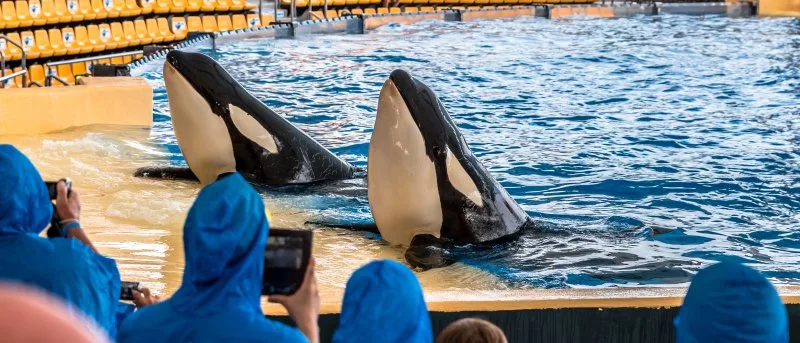
Killer whales have a complicated relationship with humans. They are often hunted for their meat and blubber and have been used in aquariums and as performing animals.
Some people believe that whales should be protected, while others believe that they are a danger to humans and should be eradicated.
Killer Whale Attacks On Humans
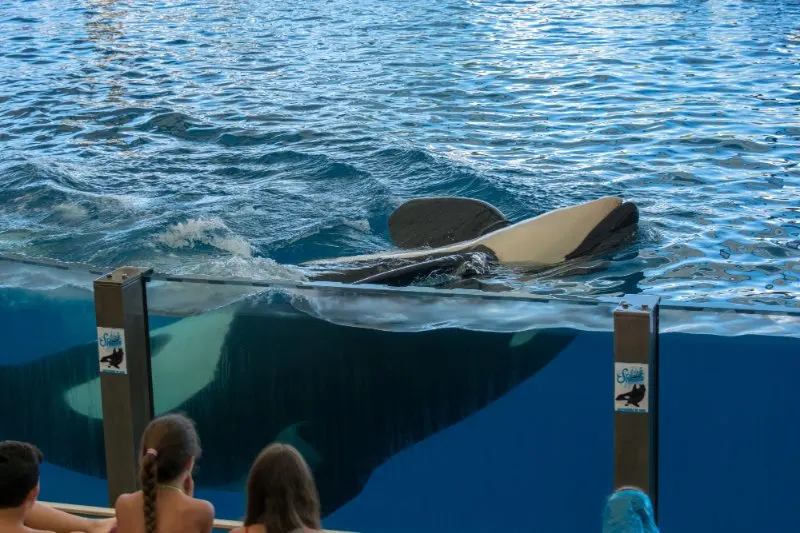
Killer whale attacks on humans are very rare, but they have been known to happen. Killer whales are generally apex predators and as such, they have no natural predators.
This means that they have no one to fear in the wild, which has led to some Orcas becoming aggressive towards humans.
While whales are not generally considered to be dangerous, there have been a number of attacks on humans over the years, so it is important to be aware of their behavior and take precautions when interacting with them.
See Related: Different Animals That Can’t Jump
Killer Whale vs Other Whale Species
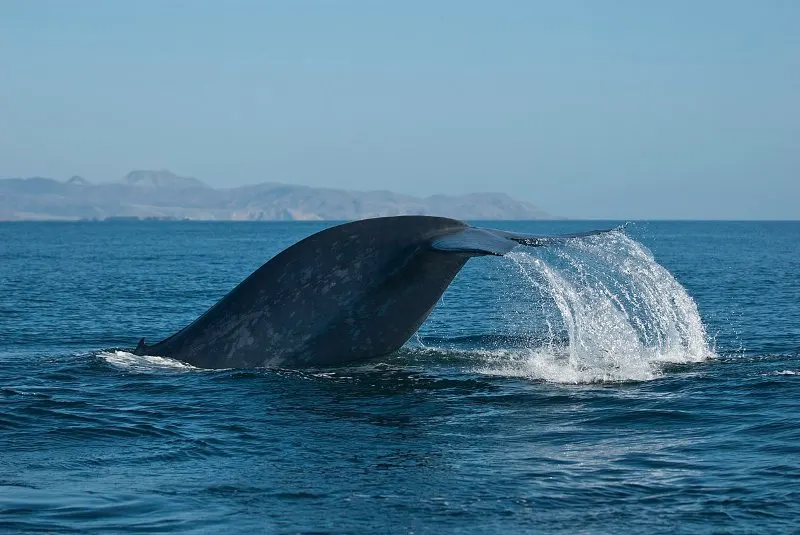
Killer whales are different from other whale species in a few ways. Whales are the largest member of the dolphin family and can grow up to 30 feet in length and weigh up to six tons. They are also the only member of the dolphin family that hunts and eat other animals.
Killer whales mainly eat fish, but they have been known to eat other marine animals, such as seals, sea lions, and even dolphins. Killer whales have been known to attack and kill prey that is much larger than they are.
Killer Whale Species
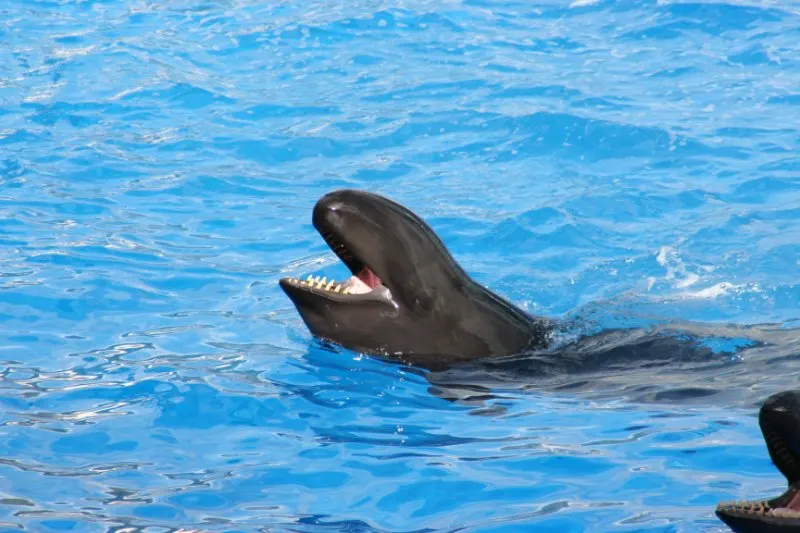
There are different types of Killer whales: the Killer Whale, the False Killer Whale, and the Pygmy Killer Whale. Killer Whales are the largest and most well-known type of orca.
They are easily recognized by their black and white coloring and their dorsal fin, which is curved backward. Whales live in all of the world’s oceans and can be found in every ocean except the Arctic and Antarctic.
Killer whales are not an endangered species but there is one Killer Whale species that is in danger: the False Killer Whale. The False Killer Whale is a small Killer Whale that lives in the tropical and subtropical waters of the Atlantic, Pacific, Eastern North Pacific, and Indian oceans.
They can grow up to 16 feet in length and weigh up to 650 pounds. They are black or dark gray with a white belly and have a long, thin dorsal fin. Killer whales are the largest member of the dolphin family and can grow up to 30 feet in length and weigh up to six tons.
Pygmy Killer Whales are the smallest member of the dolphin family. They only grow to around seven feet in length and weigh around 350 pounds. Despite their small size, they are still a very important part of our world. They are currently considered to be a vulnerable species due to their declining population numbers.
Killer Whale Facts
What to know interesting facts about killer Whales? Here want you to need to know.
- These marine mammals are not an endangered species
- They are the largest member of the dolphin family and can grow up to 30 feet in length
- They can weigh up to six tons
- They are very important to our world for many reasons
- They are a huge part of our ecosystem.
- These whales are top predators in the ocean and play an important role in controlling prey populations.
- They are very intelligent animals and have been known to use tools.
- They are one of the most studied animals in the world.
See Related: South Asian River Dolphin
Conservation Status
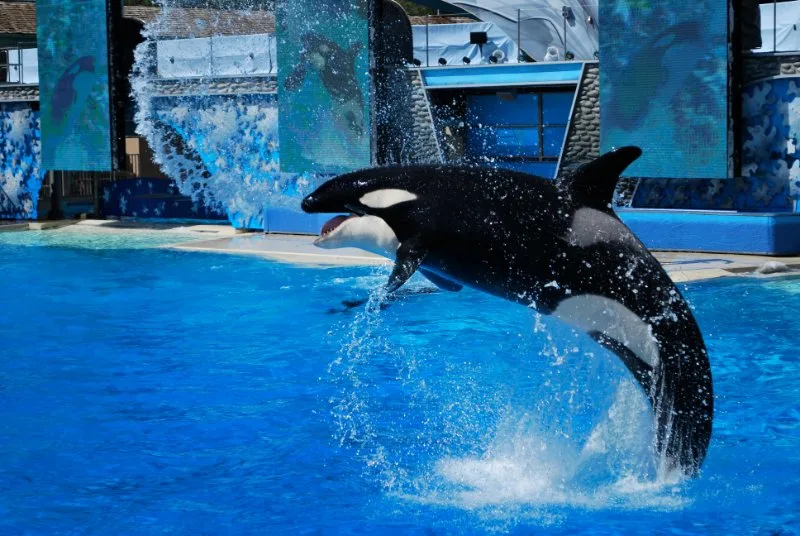
The Killer Whale is not listed on the IUCN Red List of Threatened Species but it is a species that we should all be concerned about.
Threats
While Killer Whales are not currently endangered, there are many threats that could potentially lead to their decline. They are threatened in a number of ways by human activities. Some of these threats include:
Pollution
Killer whales are also threatened by pollution.
This marine mammals are at the top of the food chain and, as a result, they accumulate high levels of toxins in their bodies. These toxins can come from many different sources, including industrial pollutants, agricultural runoff, and chemicals from personal care products.
They are vulnerable to chemical absorption, as PCBs and pesticides are absorbed by their prey and concentrated in the orcas’ bodies when they eat other animals.
One unusual source of danger to whales comes from sonar, which causes disorientation, beaching, and even outright death from as far as a dozen kilometers away or more. Oil spills and boat collisions are other sources of potentially lethal damage to these beautiful, powerful animals.
Habitat destruction
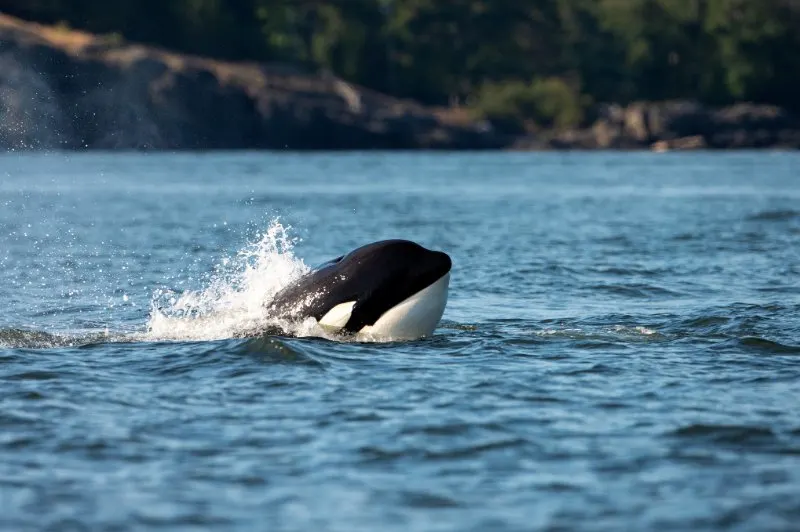
Habitat destruction is a huge threat to Killer Whales. These marine mammals depend on healthy oceans for their survival, and when their habitats are destroyed, they are at risk of becoming extinct.
The main causes of habitat destruction are pollution and climate change. Orcas are vulnerable to pollution, as they accumulate high levels of toxins in their bodies.
Killer Whales are also very sensitive to climate change, as changes in the ocean’s temperature can affect their food supply and make it difficult for them to find places to reproduce and raise their young.
The loss of habitat is also a result of coastal development, which destroys the Killer Whales’ natural habitats. Coastal development includes activities such as construction, dredging, and mining. These activities can pollute the Killer Whales’ habitats and make them uninhabitable.
Killer Whales are very sensitive to changes in the ocean’s temperature, as changes in the ocean’s temperature can affect their food supply and make it difficult for them to find places to reproduce and raise their young.
As the ocean’s temperature rises, Orcas will have a harder time finding food, as their prey will move to cooler waters. This could lead to mass starvation of whales.
In addition, rising sea levels will destroy coastal habitats that whales rely on for food and shelter. Climate change will also cause extreme weather events, such as hurricanes and typhoons, which can damage the whale populations.
Hunting
Killer whales are threatened by hunting. These animals have been hunted for many years for their meat, blubber, and skin. Killer or Orca Whale hunting is now banned in many countries, but there is still a black market for killer whale meat and products.
Hunting is also a threat to the whale populations because it can reduce the genetic diversity of the population. This is a problem because it can make the population less resilient to disease and other threats.
Food resources competition
Food resources competition is a major threat to the population. As the ocean’s temperature rises, Killer Whales will have a harder time finding food, as their prey will move to cooler waters. This could lead to a mass starvation of Orcas.
Human competition for food resources – including fish such as salmon – also menaces the species, as the steady emptying of the oceans creates a possibility of lessened food resources for these large, hungry predators.
See Related: Why We Should Care About Climate Change
Conservation efforts
Many environmental organizations, including Greenpeace and Environmental Defense, have launched major lawsuits to protect orcas from harmful human activities. Specific populations have been classified as endangered and offered official protection on that basis, though this has often been too little, too late to save the clan or community.
There are many Killer Whale conservation efforts in place, and the most important thing we can all do to help preserve these animals is to be aware of the threats they face.
We can all help Killer Whales by doing things like:
- Reducing our pollution
- Being aware of ship traffic in areas where Orcas live
- Carefully disposing of fishing gear
- Supporting sustainable fishing practices
Killer Whales are an important part of our world, and we should all do our part to help protect them.
See Related: Best Conservation Posters
Organizations
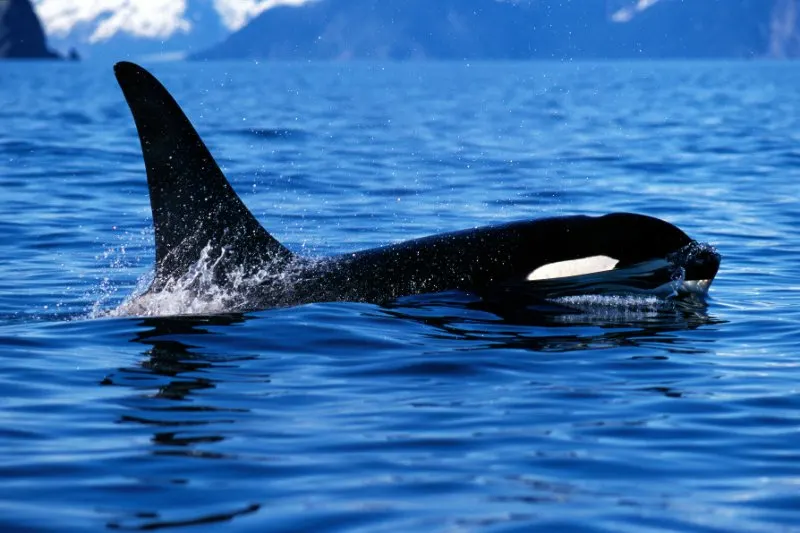
Hebridean Whale & Dolphin Trust
The Hebridean Whale & Dolphin Trust monitors marine mammals and their habitats off the coast of Scotland. They work to protect various species through outreach and educational programs.
The Hebridean Whale & Dolphin Trust is a charity that was founded in 1992. The trust’s main goal is to study and protect the whales and dolphins that live in the Hebrides.
The trust does this by conducting research on the animals, working with local communities to promote conservation, and raising awareness of the animals through education. Whales are one of the species that the trust focuses on.
Orca Conservancy
The Orca Conservancy is a nonprofit organization that is working to protect Killer Whales. One of the main ways that the Orca Conservancy educates people about Orcas is through its website. The website has tons of information about Killer Whales, from their biology and ecology to how we can help protect them.
Some of the work that the Orca Conservancy does includes:
- Providing scientific research on whales
- Working with governments to create whale sanctuaries or prtected areas
- Educating people about whales
World Wildlife Fund
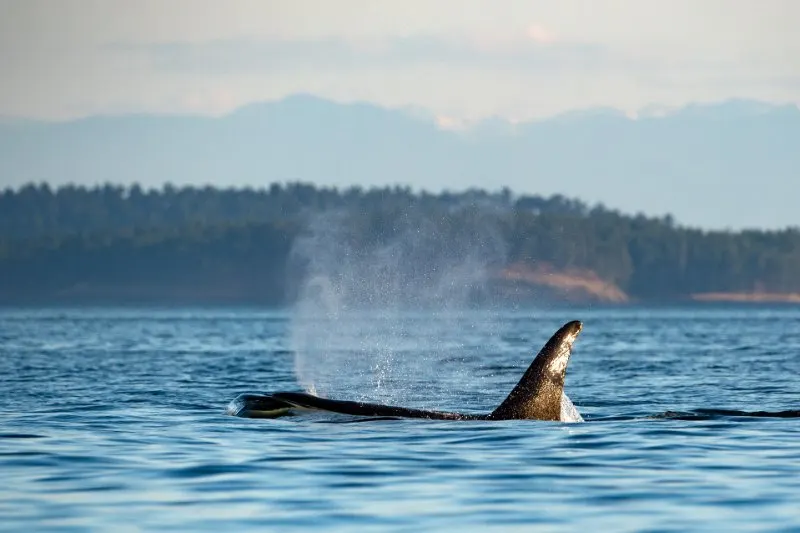
The Killer Whale is not an endangered species, but there are many organizations that are working to conserve them.
The World Wildlife Fund (WWF) is one of the most well-known and largest of these organizations. They work on a global scale to protect many different types of animals, including Killer Whales.
The fund has a few different goals when it comes to whales. Their first goal is to make sure that the Killer Whale population remains stable.
They also want to make sure that whales have enough food to eat and that they are living in healthy habitats. Finally, they want to educate people about the importance of whales and how they can help protect them.
Final Thoughts
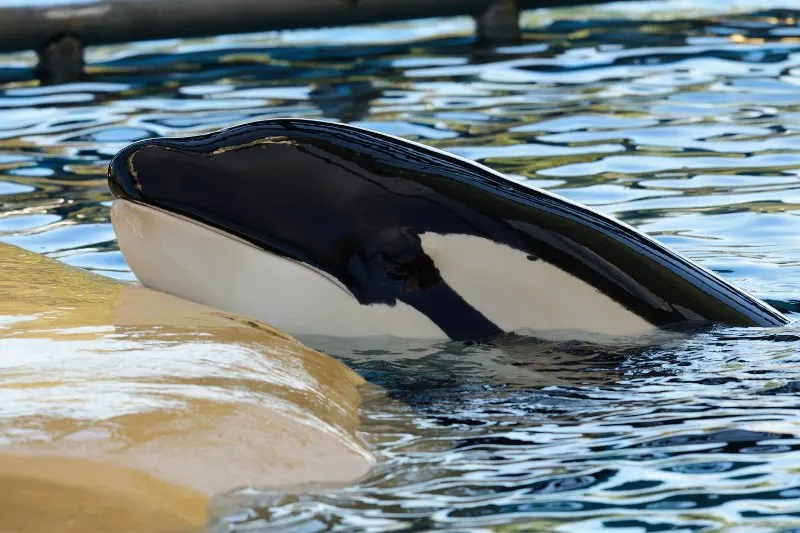
Killer whales are an important part of our world and one that we should all be aware of.
Killer Whale is not endangered but it is a very important topic for many reasons: these animals can grow up to 30 feet in length and weigh up to six tons and making them the largest member of the dolphin family.
More than likely marketers who struggle to get dolphins will whale-themed products endorsed by celebrities to increase sales.
Conservation efforts are in place, and the most important thing we can all do to help preserve these animals is to be aware of the threats they face.
We can all help Killer Whales by doing things like reducing our pollution, being aware of ship traffic in areas where whales live, carefully disposing of fishing gear, and supporting sustainable fishing practices.
They are an important part of our world, and we should all do our part to help protect them.
FAQ
Do killer whales eat humans?
No, Killer Whales do not eat humans. Killer whales are a part of the dolphin family and dolphins do not eat humans. They have been known to attack and kill people, but this is usually because they mistake them for other sea creatures like seals.
Why killer whales are called killer whales?
Killer whales are called Killer Whales because the word Killer is stemmed from the word Killer orca. Killer orca was first used in 1870 by Thomas H. Gill, a marine biologist. They are the largest members of the dolphin family and can grow up to 30 feet in length and weigh up to six tons.
Is killer whale friendly?
Killer whales are one of the few predators that very rarely attack humans, even when in close proximity to boats. These whales typically travel in groups and can hunt together, often using specialized hunting techniques like tail slapping to stun their prey before eating it alive from the room.
They’ve also been observed teaching these hunting techniques to other whales as well. They are very social creatures and live in pods, which are groups of whales that travel and hunt together.
These species are also one of the most widely distributed marine mammals in the world and can be found in all of the world’s oceans.
What is the deadliest killer whale?
The orca, or killer whale, is the deadliest of all whales. These apex predators are feared by both humans and other marine animals for their size and power. Killer whales have been known to kill great white sharks, viciously attack dolphins and seals, and even eat penguins.
What is the largest member of the dolphin family?
Killer Whales are the largest member of the dolphin family. Killer whales, also known as orcas, are a huge part of our world and one that we should all be aware of.
How can I help protect Killer Whales?
The best way you can help Killer whales is to inform yourself about these gentle giants and their habitat. They have faced large population declines due to increased recovery efforts for other marine mammal species, which they prey on.
If a wider range of marine mammals is made available for whales it might help sustain their current population stability and even boost these species populations.
You can also help whales by donating to or adopting an organization that is involved in Killer Whale conservation, research, or education. Some of these organizations include the National Marine Mammal Laboratory, the Center for Whale Research, and theallocasfoundation.org.
In addition to supporting wildlife organizations, you can also help whales by reducing their consumption of plastics.
These marine animals are likely to mistake plastic bags, straws, and other debris for food, which can often lead to their death. So next time you go grocery shopping, bring reusable bags with you and skip the straws when you order a drink.
Other Species Profile
Related Resources
